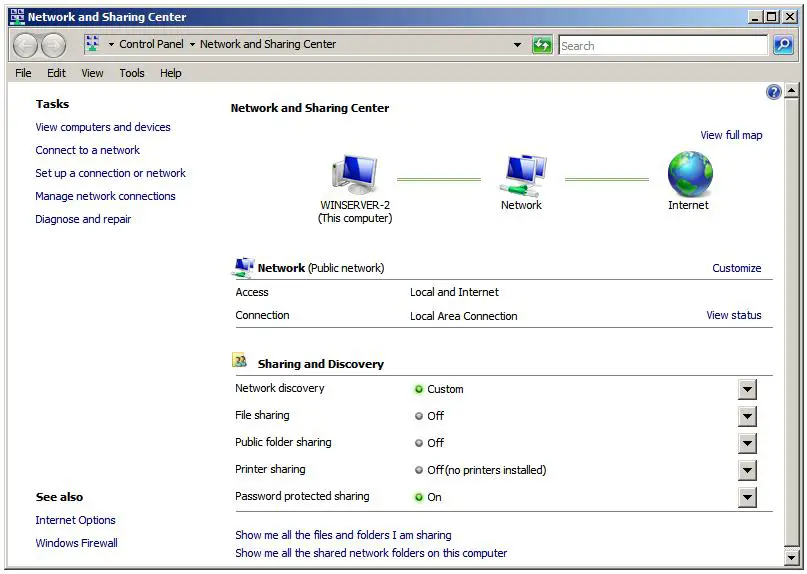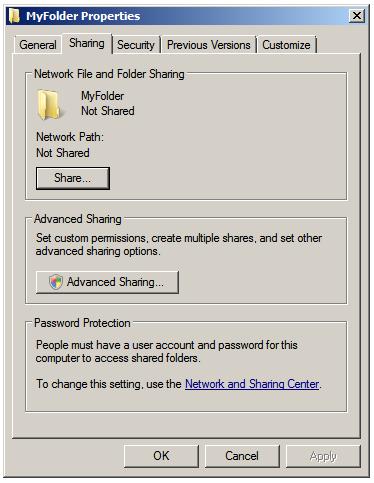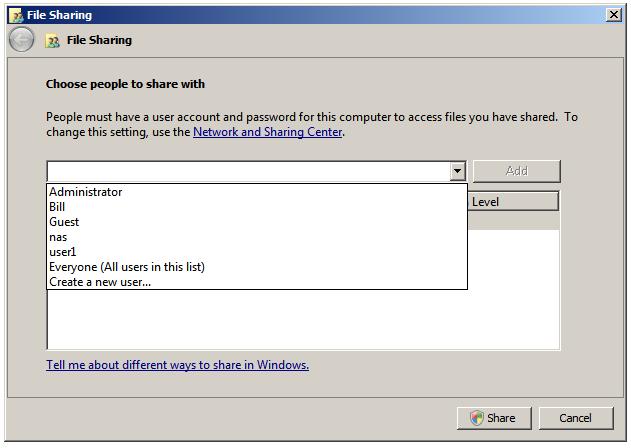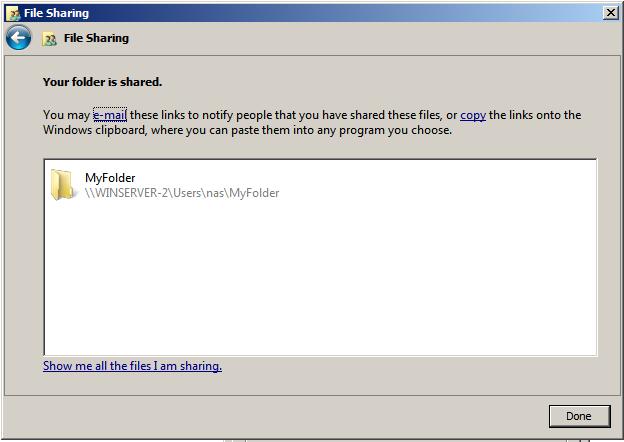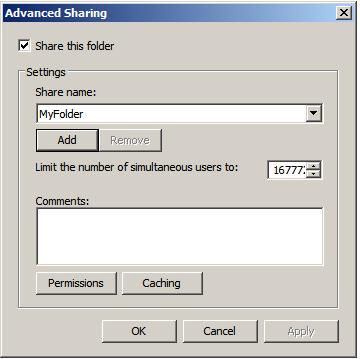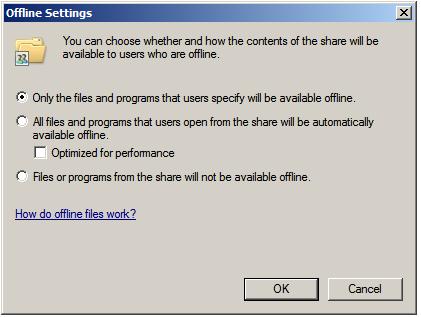Difference between revisions of "Configuring Windows Server 2008 File Sharing"
(→Creating Shared Folders) |
(→Creating Shared Folders with Windows Explorer) |
||
| Line 30: | Line 30: | ||
== Creating Shared Folders with Windows Explorer == | == Creating Shared Folders with Windows Explorer == | ||
| + | |||
| + | Shared folders can be configured using Windows Explorer, simply by navigating to the folder to be shared, right clicking on the folder and selecting ''Properties'' from the menu. In the properties dialog, click on the ''Sharing'' tab to display and modify the current shared folder settings as illustrated in the following figure: | ||
| + | |||
| + | |||
| + | [[Image:windows_server_2008_file_sharing_properties.jpg|Configuring the Windows Server 2008 folder sharing properties]] | ||
| + | |||
| + | |||
| + | |||
| + | Within the sharing property panel, click on the ''Share...'' button to access the ''File Sharing'' dialog. Within this dialog, the users who may access this shared folder are specified. If file sharing has been restricted to users with local accounts and passwords, a list of users can be obtained by clicking on the down arrow. In this situation, select and add users, or select ''Everyone'' if access is to be made available to all users with local accounts: | ||
| + | |||
| + | |||
| + | [[Image:windows_server_2008_configuring_share_users.jpg|Selecting which users have share access to a folder]] | ||
| + | |||
| + | |||
| + | Once these settings are complete, click on the ''Share'' button to initiate the file sharing process. Once this initial phase of the share setup is complete a dialog will appear announcing this fact, listing the full Universal Naming Convention (UNC) path to the shared folder and providing the option to email users to notify them of this fact: | ||
| + | |||
| + | |||
| + | [[Image:windows_server_2008_folder_shared.jpg|Selected folder is now shared]] | ||
| + | |||
| + | |||
| + | Having specified which users will have access to the folder the step is to enable the sharing of the folder, specify ''share permissions'' and configure a ''Share Name'' by which the folder will be referenced and accessed. In addition caching of shared files can be configured. Caching allows users to maintain local copies of shared files so that they can be accessed ''off-line'' (for example when the server hosting the files is not available to the user's local system). With caching configured, local copies of shared files are stored on the user's local system so that they can be accessed without a connection to the server. When a connection is re-established, any changes made to the local copy of the file are syncronized with the original copy on the server. | ||
| + | |||
| + | To configure these settings, click on the ''Advanced Sharing'' button to display the following dialog: | ||
| + | |||
| + | |||
| + | [[Image:windows_server_2008_advanced_file_share_settings.jpg|Configuring advance file and folder share settings]] | ||
| + | |||
| + | |||
| + | In this dialog, set the ''Share this folder'' to enable the sharing of the folder. Once this has been selected the ''Share name'' field and associated button will activate enabling a share name to be entered. By default the name of the folder being shared will be displayed, although this may be changed to another name if desired. If the number of concurrent users accessing a shared folder is of concern, modify the number of simultaneous users accordingly. Enter optional comments about the share before clicking on ''Caching'' to configure the ''off-line'' file settings. This will invoke the ''Offline Settings'' dialog where a number of options are available including allowing each user to specify which files they would like to be able to access off-line, only having files that user's actually access available off-line and disabling off-line sharing all together: | ||
| + | |||
| + | |||
| + | [[Image:windows_server_2008_offline_sharing_settings.jpg|Configuring Windows Server 2008 offline (cached) file sharing]] | ||
| + | |||
| + | |||
| + | The final step in the folder sharing setup is to click on ''Permissions'' to configure the ''share permissions'', details of which are covered in a later section of this chapter. | ||
| + | |||
| + | == Creating Shared Folders with Computer Management == | ||
Revision as of 15:26, 13 August 2008
Given that Windows Server 2008 is a server operating system is not surprising that a primary function of this operating system is to serve files to users on other systems on a network. The primary focus of this chapter, therefore, is the sharing of files and folders on Windows Server 2008
Standard and Public File Sharing
Windows Server 2008 supports two types of file sharing, referred to as public file sharing and standard file sharing.
In the case of public file sharing any files to be shared must be copied to the server's Public folder located at %SystemDrive%\Users\Public. Once placed in this folder the files are accessible to any users logged locally onto the machine and, if enabled, to any network users. Public sharing provides some control over access to the files. For example, when the server belongs to a workgroup the public folder can be password protected. In addition, network access to files within the public folder can be restricted to reading and executing only or given permission to read, write, create and delete files.
Standard file sharing, which is only permitted on NTFS volumes, allows individual folders files and volumes to be shared to specific users. This provides far greater levels of security over network access through a combination of NTFS permissions and share permissions, and avoids the necessity to move files from their existing location in order to share them.
Enabling Windows Server 2008 File Sharing
File sharing in Windows Server 2008 is managed from the Network and Sharing Center, accessed by selecting Start -> Network and clicking on the Network and Sharing Center button in the toolbar. Once invoked, the Network and Sharing Center will list the current file sharing configuration and options as illustrated in the following figure:
To enable public file sharing, click on the down arrow next to the Public folder sharing in the section entitled Sharing and discovery. This will provide the following list of public folder sharing options:
- Turn on sharing so anyone with network access can open files - Allows network users to open, but not delete, modify or create files in the server's public folder.
- Turn on sharing so anyone with network access can open, change and create files - Allows network users to open, modify, delete and create files in the public folder.
- Turn off sharing (people logged on to this computer can still access this folder) - Allow public folder access only to those users locally logged on to the server. Network users are denied access.
Similarly, standard file sharing can be configured by click the down arrow next to File sharing. When unfolded, this panel provides the option to either enable or disable standard file sharing on this server. When enabled, a dialog will appear providing the option to make the shared folders available only to the private network on which the system resides, or to make sharing available to public networks. The choice here depends on the requirements of the organization but for security purposes it is typically best to limit sharing to the private network unless external access is required.
The Network and Sharing Center also allows password access to shared folders to be configured. When the arrow next to Password protected sharing is selected the options to enable or disable password protection sharing are provided. When enabled on workgroup servers, only users with user accounts and passwords on the server will be able to access shared files and folders.
Shared folders can be configured using Windows Explorer, simply by navigating to the folder to be shared, right clicking on the folder and selecting Properties from the menu. In the properties dialog, click on the Sharing tab to display and modify the current shared folder settings as illustrated in the following figure:
Within the sharing property panel, click on the Share... button to access the File Sharing dialog. Within this dialog, the users who may access this shared folder are specified. If file sharing has been restricted to users with local accounts and passwords, a list of users can be obtained by clicking on the down arrow. In this situation, select and add users, or select Everyone if access is to be made available to all users with local accounts:
Once these settings are complete, click on the Share button to initiate the file sharing process. Once this initial phase of the share setup is complete a dialog will appear announcing this fact, listing the full Universal Naming Convention (UNC) path to the shared folder and providing the option to email users to notify them of this fact:
Having specified which users will have access to the folder the step is to enable the sharing of the folder, specify share permissions and configure a Share Name by which the folder will be referenced and accessed. In addition caching of shared files can be configured. Caching allows users to maintain local copies of shared files so that they can be accessed off-line (for example when the server hosting the files is not available to the user's local system). With caching configured, local copies of shared files are stored on the user's local system so that they can be accessed without a connection to the server. When a connection is re-established, any changes made to the local copy of the file are syncronized with the original copy on the server.
To configure these settings, click on the Advanced Sharing button to display the following dialog:
In this dialog, set the Share this folder to enable the sharing of the folder. Once this has been selected the Share name field and associated button will activate enabling a share name to be entered. By default the name of the folder being shared will be displayed, although this may be changed to another name if desired. If the number of concurrent users accessing a shared folder is of concern, modify the number of simultaneous users accordingly. Enter optional comments about the share before clicking on Caching to configure the off-line file settings. This will invoke the Offline Settings dialog where a number of options are available including allowing each user to specify which files they would like to be able to access off-line, only having files that user's actually access available off-line and disabling off-line sharing all together:
The final step in the folder sharing setup is to click on Permissions to configure the share permissions, details of which are covered in a later section of this chapter.
